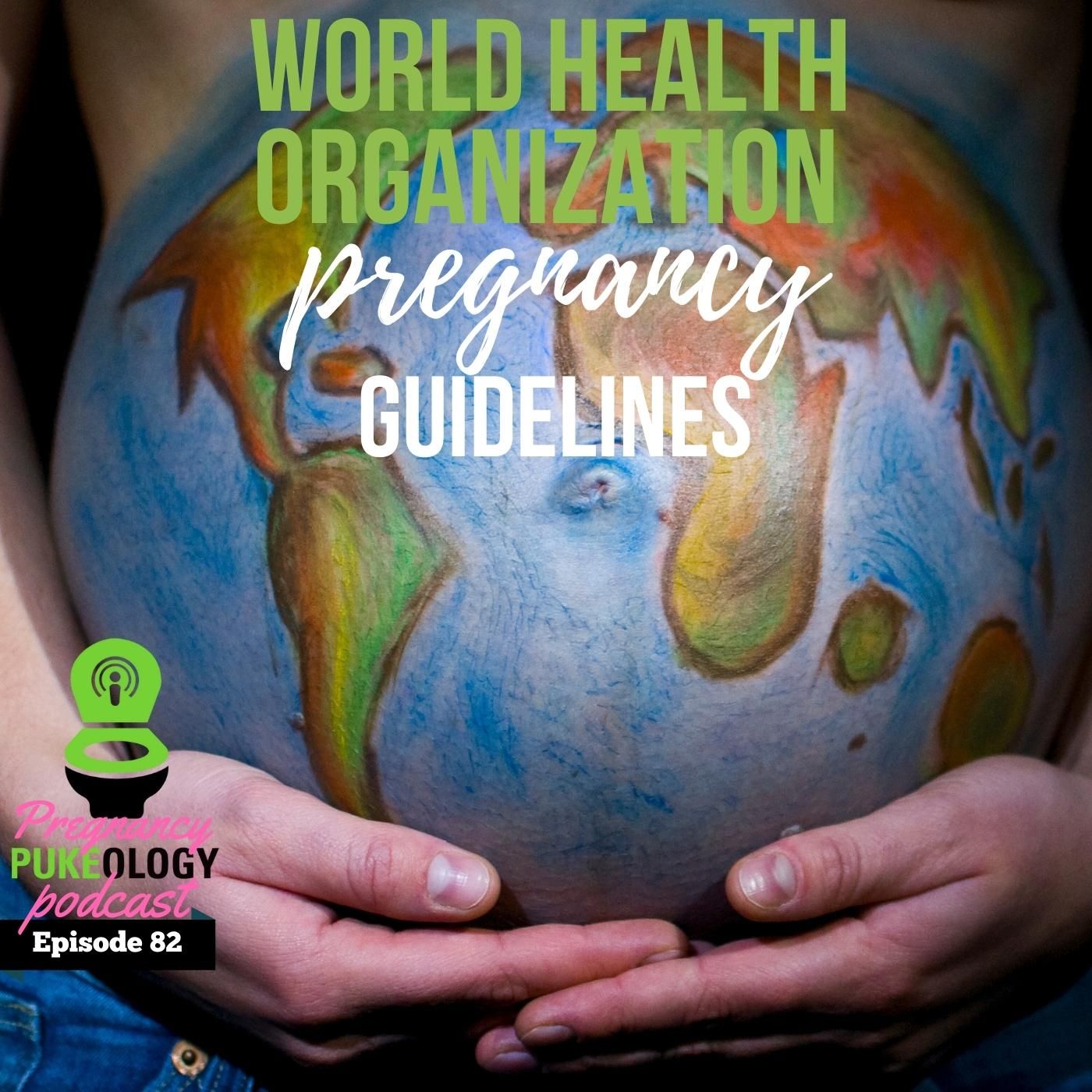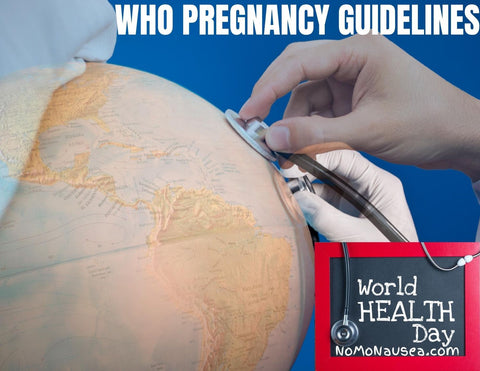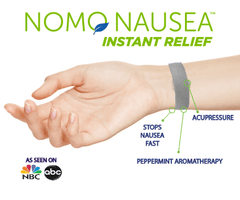
WHO pregnancy guidelines
According to the World Health Organization (WHO), about 303,000 women lost their lives in 2015 due to pregnancy complications. Furthermore, 2.6 million cases of stillbirths were reported in the same year.

Every woman wants a healthy pregnancy and recommendations from the World Health Organization (WHO) helps define the WHO criteria for gestational diabetes, pregnancy, breastfeeding, and even WHO criteria for metabolic syndrome. Sometimes, pregnancy may have adverse outcomes and it is this organizations job to look into pregnancy statistics all over the world.
The above statistics were a wakeup call to establish a better prenatal also known as antenatal program to offer health promotion, screening, diagnosis, and treatment of diseases that cause adverse outcomes in pregnancy.
Read more to learn about WHO pregnancy recommendations or if you're a busy mama and don't have time just listen in the car to our Pregnancy Podcast Pukeology.
WHO Pregnancy Guidelines
World Health Organization defines a positive pregnancy as maintaining physical and sociocultural normality, maintaining a healthy pregnancy for mother and baby, including preventing or treating risks, illness, and death, having an effective transition to positive labor and birth, and achieving positive motherhood, including maternal self-esteem, competence, and autonomy.
We also want you to have a positive pregnancy! Morning sickness is normal during the first trimester, but our pregnancy doctor invented a natural way to ease pregnancy nausea and vomiting with an essential oil infused anti-nausea wristband called NoMo Nausea Band that is trusted in hospitals in over 12 countries of the world to stop labor and delivery nausea and vomiting. Make sure you have one during your first trimester and in your delivery room bag.

Therefore, WHO released comprehensive recommendations to help maintain a healthy, positive pregnancy. The recommendations are taken into consideration the antenatal nutrition, maternal and assessment of the fetus. Also included are preventative measures, interventions common symptoms in pregnancy, and system intervention to improve quality of care.
How often do you go to the doctor when pregnant? Pregnancy Planner

The WHO pregnancy guidelines includes:
- Pregnant women should start antenatal clinic during the first 12 weeks and seven other follow-up visits at 20, 26, 30, 34, 36, 38, and 40 weeks of gestation, respectively.
- An early pregnancy ultrasound is also recommended before 24 weeks to establish the correct gestational age, identify multiple gestations and fetal abnormalities.
- Screening for diseases such as HIV, malaria, TB, and hepatitis B is done during the visits.
- Women to be encouraged to avoid tobacco and alcohol use during pregnancy. Substance use during pregnancy can result in adverse pregnancy outcomes such as low birth weight and fetal alcohol syndrome.
- Pregnant women are to be given immunization against conditions such as tetanus.
WHO criteria for gestational diabetes
WHO recommended that gestational diabetes is diagnosed if one or more of the following criteria are met:
- Fasting plasma glucose (FPG) 5.1-6.9 mmol/L
- 1 hour plasma glucose (PG) >0mmol/L
- 2 hour PG 8.5-11.0 mmol/L
This next group was already diagnosed with GDM
- FPG >0mmol/L
- 2 hour PG > 1mmol/L

WHO criteria on diagnosis of gestational diabetes (GDM) was adopted in 2013, which positively impacted pregnancy outcomes and identified women with a future risk of type 2 diabetes. Did you know 50% of women with gestational diabetes will later go on to develop type II diabetes? That’s an astounding number but if that’s you, you can lower your risk by reaching a healthy body weight after delivery.
WHO criteria for metabolic syndrome
Metabolic syndrome is a group of conditions that occur together which increases your risk of type 2 diabetes, heart disease, and stroke. Common conditions like increased high blood sugar, blood pressure, abnormal cholesterol, high triglyceride levels, and the greatest risk factor is central obesity, also known as fast around the middle of your body.
Remember how I said that 50% of women with gestational diabetes will have type II diabetes later in life and that the best thing you can do is return to a healthy weigh, well here’s why.
WHO criteria for metabolic syndrome
ATP-III (National Cholesterol Education Program Adult Treatment Panel III) guidelines consist of three or more of the following:
- fasting plasma glucose ≥110 mg/dl
- serum triglycerides ≥150 mg/dl
- serum HDL cholesterol <40 mg/dl
- BP ≥130/85 mmHg or on BP medication
- waist girth >102 cm.
How long should you wait to get pregnant again?
WHO pregnancy interval
It is recommended that you get birth after a short or very long period from the time you gave birth. According to WHO, a woman should get pregnant again at least 24 months after having a live birth. The recommended birth interval is 33 months.

Short birth interval (less than 18 months)l or long birth interval (more than 59 months) between consecutive pregnancies are associated with adverse pregnancy outcomes such as premature rupture of membranes resulting in premature births, low birth-weight babies, uterine rupture, and abruption placenta.
Some of the causes of short birth intervals include
- Shorter breastfeeding.
- Having a previous female child.
- Younger maternal age
- Low level of education
- Adverse outcome of the previous pregnancy.


Whether it's your first pregnancy, second, or more, know that NoMo Nausea Bands are here for you to stop morning sickness before it starts.
WHO pregnancy nutrition guidelines
WHO also provide nutrition guidelines to boost pregnancy outcome. These include.
- All pregnant women are encouraged to seek counseling about healthy eating and keep physically active to stay healthy and prevent excessive weight gain. A healthy diet provides energy, protein, vitamins, and minerals. It includes green and orange vegetables, meat, fish, beans, fruits, and whole grains.

The woman should start gaining average gestational weight after 20 weeks of gestation.
- It's also recommended that pregnant women take daily oral iron and folic acid supplements with 30 to 60ng of elemental iron and 400mcg of folic acid to prevent maternal anemia, puerperal sepsis, low birth weight, and preterm birth.
- Other recommended supplements during pregnancy include zinc, calcium, and vitamin A, especially when a woman is from a region where these minerals are deficient. Vitamin A is offered to prevent night blindness. While calcium is recommended to reduce the risk of developing high blood pressure during pregnancy, a condition called preeclampsia.
WHO breastfeeding recommendation
Both WHO and UNICEF recommended that babies be breastfed within the first hour of birth and be exclusively breastfed for the first six months of life. Breastmilk is the ideal food for infants because it contains antibodies to protect them against childhood illnesses. They go on saying that breastfeeding is one of the most effective ways to ensure a child’s health and survival, but unfortunately 3 in 5 children are not breastfed within their first hour of life and 2 out of 3 infants are not exclusively breastfed for 6 months (that’s only 41%).

Even with modern technology and a wealth of medical knowledge, these rates have not improved in two decades. Breastfed children perform better on intelligence tests and are less likely to be obese and less prone to diabetes later on in life. Did you know that breastmilk provides all he energy and nutrients needed for the first 6 months of life? That nutritional value is half from 6 months to a year and drops to a third during the second year of life. WHO breastfeeding recommendation could save nearly 820,000 children yearly.
World Health Organization
Every woman has a right to have a healthy pregnancy. While one cannot predict the outcome of every pregnancy, following the WHO pregnancy guidelines can increase the chances having a positive pregnancy.
